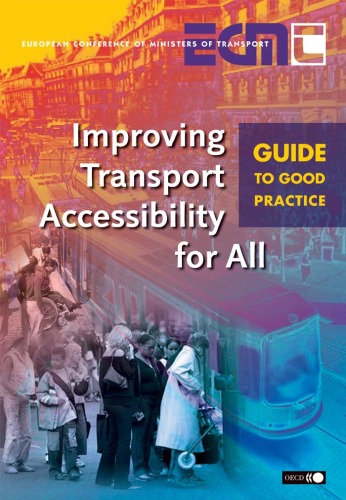

Most ebook files are in PDF format, so you can easily read them using various software such as Foxit Reader or directly on the Google Chrome browser.
Some ebook files are released by publishers in other formats such as .awz, .mobi, .epub, .fb2, etc. You may need to install specific software to read these formats on mobile/PC, such as Calibre.
Please read the tutorial at this link: https://ebookbell.com/faq
We offer FREE conversion to the popular formats you request; however, this may take some time. Therefore, right after payment, please email us, and we will try to provide the service as quickly as possible.
For some exceptional file formats or broken links (if any), please refrain from opening any disputes. Instead, email us first, and we will try to assist within a maximum of 6 hours.
EbookBell Team

5.0
50 reviews
ISBN 10: 9282101401
ISBN 13: 9789282101407
Author: Organization for Economic Cooperation
Making transport vehicles and infrastructure more accessible to everyone continues to be both an important objective and a major challenge for transport authorities, operators and service providers worldwide. Accessibility has long been considered as a transport concern only for individuals with particular mobility difficulties. But it is now increasingly recognized as an integral part of high-quality, sustainable transport systems, with benefits accruing to all clients. Much has been done to improve the accessibility of transport systems in recent years. One of the key factors in progress has.
1. Information to Improve Transport Accessibility
1.1 Clarity
– Overall Information
– Information at Stations and Stops
1.2 Conciseness
– Hearing Information
1.3 Accuracy and Timeliness
– General Information
– Multi-modal Journeys
2. The Road and Pedestrian Environment
2.1 Footpaths and Walkways
2.2 Junctions and Road Crossings
2.3 Pedestrianised Areas
2.4 Roadworks: Holes and How to Avoid Them
2.5 Tactile Surfaces
2.6 Car Parking
2.7 Longer Road Journeys
2.8 Summary
3. Infrastructure
3.1 Introduction
3.2 Getting into the Building
3.3 Moving Within Buildings
3.4 Boarding Vehicles
4. Vehicles
4.1 Buses and Coaches
4.2 Taxis
4.3 Trams and Light Rail
4.4 Heavy Rail
4.5 Aircraft
4.6 Ferries and Ships
4.7 Cable Cars and Funiculars
5. New and Innovative Transport Services
5.1 Demand-Responsive Individual Transport
5.2 Demand-Responsive Shared Transport
5.3 Community Transport and Shared Transport Services
5.4 Variations on a Theme
5.5 Other Innovative Services
6. Private Cars
6.1 Advice and Guidance
6.2 Travelling and Arriving
7. The Roles of Government
7.1 National Government
7.2 Public Procurement
7.3 Local and Regional Government
7.4 Training
7.5 Seamless Travel
7.6 Raising Awareness
Annexes
– Annex 1: Members of the ECMT Working Group on Access and Inclusion
– Annex 2: Conclusions and Recommendations of the ECMT-UITP on Improving Access to Public Transport
– Annex 3: Consolidated Resolution No. 2001/3 on Accessible Transport
– Annex 4: Charter on Access to Transport Services and Infrastructure
improving accessibility
improving public transportation
accessibility to transportation
improving mobility transportation
improving transport accessibility for all guide to good practice
Tags: Organization for Economic Cooperation, Improving, Transport, Accessibility